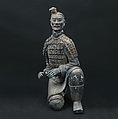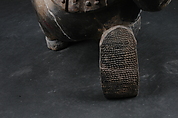Returned to lender The Met accepts temporary loans of art both for short-term exhibitions and for long-term display in its galleries.
Kneeling Archer
Qin dynasty (221–206 BCE)
Not on view
Excavations of the mausoleum of the First Emperor of Qin revealed terracotta models of 108 cavalry, 332 archers and infantry, and a combined unit of more than 300 charioteers, cavalry, and infantry, all fully armored. Based on this figure’s gestures, we can assume that he was an archer, whose original weapon—a crossbow— is now lost. He is the only figure on view here that still bears traces of color, indicating that he was once vividly painted (see the red of his armor laces and the black of his collar). Chemical analysis suggests the use of mineral pigments such as cinnabar, azurite, malachite, bone or lead white, and an artificially produced mineral pigment commonly known as “Han purple.”
#700. Kneeling Archer
-
700. Kneeling Archer
-
200. Introduction
Playlist
Due to rights restrictions, this image cannot be enlarged, viewed at full screen, or downloaded.
This artwork is meant to be viewed from right to left. Scroll left to view more.









